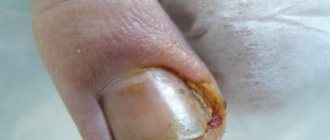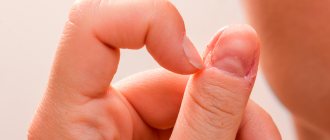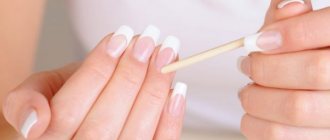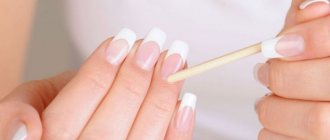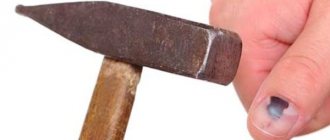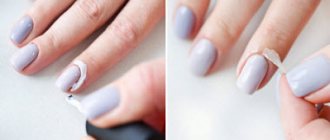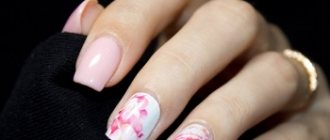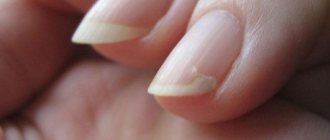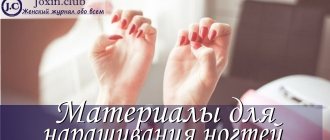Flawless nail shape and smooth skin complete the look and make it flawless. Psychologists say that the hands reveal a lot about a person. For example, about his age, social status, habits and level of culture.
Women go to beauty salons to get a beautiful manicure. When trusting the hands of a master, few people think about their health. Unfortunately, the usual procedure can lead to dire consequences if the manicure tools are not properly sterilized.
The danger of manicure
The most popular salon procedure is manicure. This fact is confirmed by the growing number of nail bars located in shopping centers. Women want to quickly get their hands in order by popping in for a manicure during their lunch break or shopping for groceries for the home.
Hygienic cleaning of nails in a salon is not only the most popular, but also the most dangerous procedure. Venereologists and dermatologists regularly treat pathologies that develop as a result of infection after a manicure. The danger of contracting hepatitis and HIV infection here is quite real if the master does not carry out a set of sterilization measures. As numerous checks have shown, many workers of even the most elite salons are guilty of this.
Cases of HIV infection after going to a beauty salon are truly extremely rare. But this is not the merit of the masters. This virus dies quickly in the open air. But hepatitis is very stable and it is quite possible to become infected with it.
Most often, the nail plate is affected by bacterial infections and fungi. Through the cuticle injured during the procedure, pyogenic cocci can enter the wound. The infection begins to develop very quickly. The process is accompanied by symptoms such as swelling and pain. This may lead to the development of complications.
Patients often turn to the therapist with complaints that their finger has become inflamed after a manicure. It is already too late to make lotions and apply ointments. The abscess must be opened surgically. To avoid this painful manipulation, measures should be taken as soon as the first symptoms of infection appear.
Alarming symptoms
The most common cause of inflammation around the nail is the use of tweezers. The infection can quickly enter microtraumas formed on the skin ridge. Unprocessed manicure tools contribute to its development.
Typically, the injured area will swell slightly a few hours after the procedure. Then, hyperemia develops and itching appears. If measures are taken at this stage, further development of inflammation can be avoided. Unfortunately, few girls pay attention to such symptoms, expecting the swelling to go away on its own. Sometimes this actually happens.
Further development of inflammation of the skin around the nail is characterized by increased swelling. The roller rises, and the pain intensifies. Gradually it acquires a pulsating character. At night, these sensations make it difficult to fall asleep. If you put a little pressure on the damaged area, the pain will become cutting.
Gradually, pus begins to accumulate under the top layer of skin. Sometimes it penetrates under the nail plate. But most often it remains under the roller and is visible through the skin.
A local increase in temperature may be observed in the affected area. The patient experiences general malaise and his lymph nodes are enlarged. Low-grade fever may also appear. In the event that the situation has gone so far, the doctor must decide how to treat the abscess on the finger.
Treatment of inflamed cuticle
Depending on the nature of the cause that caused the inflammation, treatment methods are determined.
Only a doctor can treat a cuticle affected by a fungus, because self-medication may not only worsen the skin condition, but also cause problems with nails. In addition, with a severe infection, a course of antibiotics is sometimes indicated. And any medications can only be taken as prescribed by a doctor.
With flaky cuticles, an important point for treatment is the absence of trimmed manicure. It is after this that the skin dries out and cuts appear, opening access to infections. The most correct solution is to do a non-edged manicure, in which the cuticle is carefully pushed back with a special stick. After any nail care procedures or household work, it is necessary to moisturize the skin around the nails with lotions and creams. And do housework exclusively with gloves.
At the first signs of inflammation around the nail, you should thoroughly wash and dry your hands. If there is pus, it should be removed by light pressure if it is not deep, or compresses should be made using the pulp of aloe leaves to draw it out. Baths with a strong saline solution (white vinegar, Epsom salts) or the use of special ointments will also help. After removing the pus, the wound is disinfected with hydrogen peroxide, cauterized with iodine and covered with a bandage.
You can treat the cuticle after cleansing from suppuration or with minor inflammation around the nail at home or by contacting a specialist. Essential oils are the most popular means for caring and treating the skin around the nails. The most effective are grapefruit, apricot and castor oils. If you do the procedures regularly, the inflammation will go away in a short time, and the nails and skin will become elastic.
To eliminate inflammation and improve the condition of the cuticle you need to:
- Apply lavender oil around the nail area. It is they that are best used to treat inflamed tissues, as it is a powerful antiseptic.
- Apply an ointment consisting of calendula flowers and petroleum jelly. For 0.5 cups of dry matter, take 10 grams of Vaseline. After heating in a water bath, the mixture must be infused for 10-12 hours. Then place in a convenient container, after straining.
- Rub the inside of the grapefruit peel. Thus, the cuticle can not only be disinfected, but also nourished with vitamins.
- To eliminate dying cells, rub cornmeal into wet fingers once every seven days. This natural scrub is great for cleansing.
Felon
All of the above symptoms most often accompany a disease such as panaritium. This is an acute inflammation of the tissues of the finger. It can develop on both the arms and legs. Most often it appears after a manicure, when accidental cuts and microtraumas allow infection to enter the body. Infection is caused by streptococcal, staphylococcal, enterococcal or mixed infection.
In most cases, it is felon that threatens a woman whose finger becomes inflamed after a manicure. What to do to protect yourself from this problem worries many people. The use of sterile instruments, as well as the professionalism of a manicurist, can minimize the risk of infection. If you manage to avoid cuts during the procedure, the gates to infection will not open.
Panaritium is dangerous because, in addition to the upper layers of the dermis, it can also affect the deep ones. It can affect joints, tendons and bone tissue. In advanced cases, the only way to stop the infection is amputation. Therefore, it is very important to treat the pathology in a timely manner.
Risk factors
Acute paronychia is caused by bacteria (usually staphylococci and streptococci), less often by pathogenic fungi. Chronic paronychia is usually caused by a yeast (Candida) or bacterial infection.
Causes of paronychia:
- injury to the cuticle or other periungual tissues, for example, due to the bad habit of tearing off or biting off hangnails, being pricked with a needle, thorn, or careless manicure and pedicure;
- fungal infections of the skin or nails;
- regular exposure to hot water and detergents (hand washing, dishwashing);
- contact with certain chemicals, such as antiseptics. The use of the anti-acne drug isotretinoin has been proven to cause the development of paronychia;
- The cause of paronychia toe can be tight, uncomfortable shoes.
Paronychia is more common in patients with diabetes and certain autoimmune diseases, as well as in patients taking immunosuppressive drugs.
There are acute and chronic paronychia. The acute process is usually caused by trauma to the periungual tissues and begins with redness, swelling, and pain. Chronic paronychia is an inflammation of the nail folds that lasts more than six weeks. This form is usually found in people whose hands or feet (due to the specifics of the profession) are constantly wet or often come into contact with fairly aggressive chemicals (soft alkalis, acids, and so on). In chronic paronychia, the cuticle separates from the nail plate, leaving an area vulnerable to infection open.
First aid
Conservative treatment of panaritium is possible only in the initial stages of the disease. Any wound after a manicure should be immediately treated with an antiseptic. At home, you need to additionally lubricate it with iodine or brilliant green.
If the actions taken do not bring the desired result and the finger becomes inflamed, you should prepare a hand bath. The water should be hot, but comfortable for a person. The following bath compositions are good for relieving inflammation:
- Hypertonic solution. To prepare it, pour a tablespoon of salt into a glass of boiling water. When the water has cooled a little, immerse the affected finger in it for 30 minutes.
- Potassium permanganate. Several crystals of potassium permanganate are dissolved in warm water. The color of the solution should be light pink. The finger is lowered into it for no more than 10 minutes.
- Soda solution. Two tablespoons of powder are poured into a glass of boiling water. When the water reaches a comfortable temperature, the affected finger is immersed in it for 30 minutes.
- Copper sulfate. A pinch of powder is required for 50 ml of hot water. The duration of the procedure is 15 minutes.
- Healing herbs. Take a tablespoon of calendula, chamomile and celandine. Pour two cups of boiling water over the herbs. After the infusion has cooled, use it for baths.
- Calendula. Pour three tablespoons of herbs into a glass of boiling water. Put your finger down for 15 minutes.
- Garlic baths. Pass a few cloves through a press and pour a glass of boiling water. When the liquid has cooled, use it for baths.
The methods listed should relieve discomfort if your finger hurts after a manicure. A compress with Dimexide helps complete the treatment. The drug is diluted with water in a ratio of one to four. Gauze or a cotton pad is soaked in the solution, then applied to the finger. Wrap cling film on top and leave it in place for 40 minutes.
Paronychia of the finger: treatment
Treatment of acute paronychia without pus is carried out using conservative methods. For chronic paronychia, antimycotic (antifungal) agents are indicated. If local therapy is ineffective, oral antifungal agents are prescribed.
Paronychia of the finger on the hand - treatment:
- rest of the finger;
- wet compresses;
- warm baths;
- physiotherapeutic procedures;
- Antibacterial therapy (usually broad-spectrum antibiotics or fluoroquinolones).
If, with paronychia of the finger, treatment with conservative methods does not produce results and the inflammatory process has passed into the purulent stage, then the abscess is opened and drained.
Prevention of paronychia:
- hands and feet should be dry and clean;
- If your hands are regularly exposed to water or harsh chemicals, you should use rubber gloves lined with absorbent cotton fabric;
- It is necessary to carefully treat the nail and the tissue around it during manicure and pedicure;
- It is advisable to avoid traumatic cuticle removal. It is better to use emollients and gently move it;
- you should get rid of the habit of biting your nails and the skin around them;
- If you have diabetes, monitor your blood sugar levels.
Read more about the prevention of paronychia and felon on our website https://www.dobrobut.com/.
Drug treatment
If the use of baths did not stop the development of the pathological process, and after a manicure the finger continues to tear, more serious treatment will be required. It is best at this stage to consult a doctor who will conduct an examination and assess the degree of danger. Unfortunately, this is not always possible, so you can turn to proven and accessible means:
- Ichthyol ointment. It can draw out the densest and deepest purulent formations. Ichthyol is able to effectively eliminate inflammation and swelling. Patients often notice results after the first use. The ointment is applied to the affected area in a thick layer, three times a day. A bandage is applied on top.
- "Levomekol". The medicine is applied to the affected area, covering the top with a sterile bandage. It is not recommended to use this remedy more than once a day, as it may cause an overdose.
- Vishnevsky ointment. This is truly one of the most effective home remedies, which is used if your finger becomes inflamed after a manicure. Pus may come out even after a single use of the product. The ointment is applied twice a day. The first time it is recommended to use it at night. In the morning, change the bandage and reapply the product. The steps should be repeated until the wound is clean.
- Tetracycline ointment. This remedy works most effectively in the early stages of the disease. It can be applied several times a day as it wears off. A greater effect can be achieved if you mix it in equal quantities with zinc paste.
- Syntomycin ointment. The drug stimulates healing and prevents the development of neurotic processes. The ointment contains an antibiotic and is recommended to be applied only once a day. A pea-sized amount of the product is applied to the inflamed area. Fix the top with a sterile bandage. The duration of treatment can be two weeks.
Treatment
When an abscess appears, you need to steam the nail in a bath with a solution of potassium permanganate. The water should be pale pink. The optimal temperature is 35–40 degrees.
Medicines
Next, you should use special ointments.
Vishnevsky ointment
You need to apply the product to a cotton pad, apply it to the damaged area and secure with a plaster or bandage. The procedure is done at night so that the drug is well absorbed, relieves redness, pain, and draws out pus.
Ichthyol ointment
This is a proven remedy. It should be used in the same way as Vishnevsky ointment.
Treatment with ointment should be carried out regularly until the inflammation stops.
When the abscess breaks, you need to treat the wound with an antiseptic (chlorhexidine or hydrogen peroxide will do) and apply Levomekol or Miramistin ointment and fix it. Antiseptic treatment and application of ointment must be done every day, morning and evening, until all signs of inflammation disappear.
If the abscess is large, you feel a strong tugging pain, your finger is swollen, you need to contact a surgeon, who will perform an autopsy and prescribe antibiotics and anti-inflammatory ointments. You cannot delay it, as there is a risk of being left without a nail.
Traditional methods
Folk remedies are effective in the first stages of inflammation.
Sea salt baths
Thanks to the high iodine content, baths with sea salt will help. 10 g of salt should be dissolved in 1 liter of warm water and hold your hands for 15 minutes. You can simply lubricate the cuticle with iodine. But you need to take into account that the product gives the nail a yellow color. However, it is very effective, including against fungus, so you should not neglect it.
Not only a pleasant, but also a useful procedure
Aloe
If you grow aloe at home, you need to fasten a leaf cut lengthwise on your finger and hold it for several hours. Aloe oil in special cuticle pencils also has healing and regenerating properties.
Aloe leaf is suitable for treating inflammation.
Decoction of calendula or chamomile
40 g of calendula, chamomile or oak bark should be poured into 400 ml of boiling water and boiled for 5 minutes. Leave for half an hour, then hold your hands in the broth for 10 minutes. Do the procedure 1-2 times a day.
For inflammation of the cuticle, it is recommended to carry out the procedure 1-2 times a day.
Honey with flour
Mix 15 g of honey with flour to form a homogeneous cake. Apply to the wound, fix and hold for 12–14 hours.
Sorrel and plantain
You can grind fresh sorrel and plantain leaves into a paste. Fix for 4-6 hours.
Essential oil
Essential oils help a lot. Suitable oils include lavender, tea tree, and wheat germ. It is necessary to lubricate the affected areas 3-4 times a day.
Oil nourishes the cuticle
Folk remedies
Traditional medicine recipes can effectively fight diseases. These methods have absorbed the experience and wisdom of several generations of people. Many recipes have been collected over centuries. At the same time, several treatment options are offered for each disease.
Traditional medicine knows well how to treat an abscess on a finger. She has several dozen different recipes in store for this. The most effective are the following:
- Compress with baked onions. Accelerates the maturation of the purulent capsule and accelerates the release of its contents to the outside. The onion is cut into two parts. The halves are baked in the oven. When the onion has cooled, apply it to the affected area, fix it and leave it for several hours.
- Aloe. Peel the pulp from the leaf and apply it to the inflammation.
- Castor oil. Heat the substance to a temperature of 40 degrees in a water bath. Soak gauze in oil and place it on your finger.
- Flax seeds. An excellent remedy not only for felon, but also for furunculosis. Add a tablespoon of flax seeds crushed in a coffee grinder to 250 ml of boiling milk. In addition, you can add a few dried chamomile flowers. Boil the mixture for two to three minutes and strain. Apply the resulting mass to the inflammation and secure with a bandage. Leave for three hours.
- Milk foam. If your finger becomes infected after a manicure, you need to help ensure that the infection goes away as soon as possible. To do this you will need the fattest milk you can find. The liquid should be poured into a clay pot and placed in the oven. When brown foam forms on the surface of the milk, it must be removed and applied to the affected area. Apply a bandage on top and leave it overnight. Repeat the steps in the morning. The result will not take long to arrive. By the end of the second day, the pus will come out.
- Potatoes or beets. Vegetables help prevent the development of a pus sac. A paste of fresh beets or potatoes should be applied to the inflammation after baths with a hypertonic solution or potassium permanganate.
- Honey compress. For treatment you will also need a baking onion and flour. All ingredients, mixed in equal quantities, are thoroughly ground. The resulting paste is applied to the inflamed area, covered with gauze and secured with a bandage.
Surgical intervention
There are situations when ointments and traditional recipes are not able to stop the rapid development of infection. In this case, you will have to go to the clinic. They know how to help if your finger gets inflamed after a manicure. The surgeon will be able to explain in detail what to do to the patient. Most likely you will need to open the abscess and remove the contents.
During the procedure, the doctor will remove the necrotic epidermis using local anesthesia. Then he will wash the wound and examine its bottom. The doctor must make sure that the purulent contents are completely removed. After this, he will apply an aseptic dressing and, if necessary, drainage.
The patient will be prescribed antibiotic therapy. A few days after the procedure you will need to come for an examination. If the wound is clean, no further treatment will be required.
Surgical treatment of paronychia
There are two phases of the inflammatory process - serous-infiltrative and purulent. Since the first period is very short, surgeons usually encounter a purulent clinical-anatomical form of paronychia. The inflammatory process in superficial paronychia is localized in the thickness of the fold of the periungual fold. If an abscess forms under the fold of the periungual fold closer to the edge of the base of the nail plate, then we are talking about deep paronychia. In this case, the pus moves under the exfoliated part of the nail plate, that is, paronychia is complicated by subungual panaritium. During natural development, the purulent focus can spontaneously open outward at the lateral periungual fold.
Surgical treatment of paronychia is carried out in the presence of purulent inflammation. Opening the abscess is performed under local anesthesia. If suppuration is localized under the nail plate, part of the nail is removed. In case of detachment of the nail plate, it is completely removed. The wound is drained, treated with an antiseptic, and a bandage is applied. Dressings are carried out daily until the wound heals.
Related services: Surgery
Nail fungus
Fungi can be transmitted through household items. These can be not only washcloths or towels, but also door handles and telephone handsets. But most often they are transmitted through manicure tools. Statistics show that among all nail pathologies, fungi occupy a leading position. The processing of tweezers and scissors in salons is at least somehow monitored. But the condition of the files, on which infection can settle, leaves much to be desired.
Most often, nail fungus is discovered after a manicure by girls who regularly get extensions done. At first after infection, the pathology does not manifest itself in any way. Nails may become more brittle, but under a layer of acrylic or gel this is not easily noticeable. Then the color of the plate begins to change, it becomes yellow-brown, white or greenish. The nail may thicken and change shape.
Toxins released by the fungus poison the body. The danger of infection is that it can quickly spread to all healthy nails. Therefore, the key to successful treatment is timely consultation with a doctor. If your hands itch after a manicure, this may be the first symptom of a fungal infection.
Panaritium after manicure
Panaritium is an acute inflammatory disease of the tissues of the finger. Often develops as a result of infection through small wounds, cuts, scratches, injections or as a result of manicure. Microtraumas open the gates for pathogenic microbes, which, once inside, cause inflammation. The inflammatory process can spread to the dermis, subcutaneous tissue, as well as to the joints, bones and tendons of the fingers.
Symptoms of felon: the appearance of felon is necessarily preceded by microtrauma. Swelling and redness appear in this area. A throbbing, tugging pain is felt in the area of inflammation. Panaritium may be accompanied by chills, fever and general malaise.
Superficial types of panaritium: cutaneous occurs on the finger from the back side. Pus accumulates under the top layer of skin, forming a blister with cloudy contents. The skin at the site of inflammation turns red. Pain and burning occurs. If the bubble increases in size, this indicates that the disease is progressing and moving to deeper tissues.
Periungual panaritium (paronychia): occurs when the periungual fold becomes inflamed. Often this type of panaritium is the result of improper manicure. The skin of the nail fold at the edge of the nail becomes inflamed as a result of minor skin damage (hangnails, small cracks or cuts).
Deep types of panaritium:
- Subcutaneous panaritium;
- Subungual panaritium;
- Tendon panaritium;
- Articular felon;
- Osteoarticular panaritium;
Prevention of felon: to prevent felon, for every, even minor, injury to a finger, you need to treat the wound with an antiseptic. An important means of preventing felon is clean hands. It is better not to use other people's manicure devices. When doing a manicure, you should try to injure the skin around the nail bed as little as possible.
Treatment of felon: in the first 2 days after the occurrence of felon, before suppuration develops, doctors prescribe conservative treatment. Warming compresses should not be used. If, with the treatment used, there is no improvement, but, on the contrary, suppuration appears, surgical intervention is indicated.
Find out more and make an appointment with a surgeon in Ufa:
Address: Ufa, st. Revolutionary, 70
Phones: +7 (347) 294-15-94
Mobile: +7 (987) 254-15-94 (WhatsApp)
Schedule: Mon-Fri 09:00 - 21:00; Sat 10:00 – 15:00
There are contraindications, it is necessary to consult a specialist.
Fungus treatment
Nail fungus cannot go away on its own. He needs to be treated. To choose the most effective drug, it is recommended to consult a dermatologist. The following products have proven themselves to be effective:
- "Exoderil";
- "Fluconazole";
- "Lamisil";
- "Mikozan";
- "Loceryl";
- "Clotrimazole";
- "Batrafen".
In the treatment of fungus, it is recommended to combine drug treatment and traditional medicine methods. Baths made from a decoction of medicinal herbs or sea salt help well. Additionally, the following treatment methods can be used:
- Apply a mixture of sea salt and grated mint to your nails twice a day.
- Treat the affected plates with rich sour cream mixed with vinegar.
- Apply iodine or tea tree oil to the affected areas daily.
- Mix crushed garlic cloves with vegetable oil and treat the nail plate.
- Once a day, apply 20% alcohol tincture of propolis to the affected area.
Prevention of nail diseases
Everyone knows that it is easier to prevent a disease than to treat it. But in everyday life people are too careless. They easily trust their health to professionals from a beauty bar or the nearest beauty salon, without checking the sterility of the instruments. Because of this, a situation arises when a finger suddenly becomes inflamed after a manicure. Everyone probably knows what to do to protect themselves. Unfortunately, this knowledge is rarely used in real life.
To avoid troubles and preserve your health, you should strictly monitor the master’s compliance with the following rules:
- The manicure table must be perfectly clean. Before starting to serve a new client, the technician must wash and disinfect his hands. The client should do the same.
- The manicure bath should be wrapped in a clean plastic bag. It is changed before each client.
- Tools must be packaged in a kraft paper bag, in which they are processed in a dry-heat oven. They should only be opened in front of the client.
- Files must be kept in an ultraviolet sterilizer. They should be taken out in front of the client.
- You can protect yourself from all risks if you bring your own set of instruments to the procedure.
